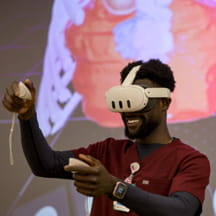Patient rounds are common for physicians, and it is standard practice to include nurses in these rounds. But the concept of nursing safety rounds is different. Separate from daily patient rounds, they performed at the bedside to identify quality and safety concerns early in a patient’s hospital stay. Safety rounds help prevent harm events because they allow multiple sets of eyes to assess the patient with the bedside nurse.
A new way of looking at patient safety
In the past at Riley Hospital for Children at Indiana University Health, the PICU clinical nurse specialist, with the unit manager’s involvement, completed safety rounds two days a week. The nurse spent one day looking solely at CLABSI bundle elements with minimal bedside nurse interaction.
Then, on the second day, the nurse tended to patients identified as high risk for skin breakdown based on Braden Q scores and the number of devices the patient needed. These rounds mainly focused on appropriate bed surfaces and padding under medical devices.
The hospital’s PICU had a change in personnel in the clinical nurse specialist role, which triggered a new way of thinking and an opportunity to look at safety rounds in a different way. After examining current practices and the needs of the unit, the PICU team decided to put a new spin on what safety rounds would look like and how they would function.
The days and times were kept the same, but how rounds were operationalized changed. In addition, the unit shift coordinator (bedside nurse), unit managers and the medical director of quality and safety for the PICU were added to the safety rounds team. Most important, the vision and focus changed from looking only at CLABSI bundle elements and patients at high risk for skin breakdown to stepping back and looking at the whole patient.
This improvement in safety rounds was built around encouraging the bedside nurse and patient’s family to collaborate on watching out for patient safety. To that end, the team moved safety rounds to the bedside, with the safety rounds team performing a collaborative assessment of the overall gaps and barriers for the bedside nurse.
This type of rounding allows the team to share ideas and identify challenges and equipment needs. What’s more, several sets of eyes observe the patient for potential harm events. This rounding makes it possible for the PICU team to be proactive instead of reactive in approaching harm events.
As with most change, the safety rounds team initially faced some challenges with the new system. For example, the bedside nurse was often “too busy” to participate. Instead of walking away, however, the team stuck with it and changed the conversation to, “How can we help you?” This showed the nurse that the team was there to help, not hinder.
In turn, this opened the door to multiple people assessing the patient, allowed opportunities for questions from all participants, and gave the team time to engage the patient’s family. The team quickly realized that timing of the rounds was crucial and scheduling them during normal nursing care times was important. This allowed the team to not only do rounds but also increased collaboration among the team.
Testing the safety rounds concept
When the new process for safety rounds began, patients were preselected on the morning of rounds based on clinical nursing judgment. The team took into consideration the level of medical/nursing support needed, the number of devices being used, the patients’ hemodynamic instability and mobility status, and that gut feeling of experienced nurses. When it comes down to it, every patient is at risk for some type of harm, so there was no wrong patient to see.
The team’s goal was to see at least two patients during each scheduled rounding time. From a timing perspective they scheduled a one-hour time frame twice a week to do rounds, spending approximately 30 minutes at each bedside. However, flexibility was always a requirement with time of rounds and time spent doing rounds.
Rounds began with the team entering the room, introducing themselves, and explaining the reason and goals of safety rounds to the bedside nurse. If family was in the room, it was important to again introduce the team and their roles and explain why and what they were doing.
Including the family in safety rounds is important, especially with chronically ill patients. After all, it is often the families who can provide insight into skin or pressure injury concerns, use of certain products, or significant history for the patient.
In the beginning, the team noticed that if the intent and goals were not explained to the bedside nurse, the rounds felt punitive—almost as if the team were nitpicking the nurse’s care, which was not at all the intent. Instead, the team worked with the bedside nurse to do a full assessment of the patient.
They looked at the devices, surfaces, skin, IV access, and drips with rates. They changed beds and linens, bathed patients and performed C-collar care; they did anything needed to keep the patient as safe from harm as possible.
During this time, the team also talked and listened to the bedside nurse’s concerns and asked questions to help better understand the patient picture. And when the patient’s family joined in on the assessment and conversations, it was a benefit to the health care team and the patient.
Family members are typically the ones who are always present and can help identify what is new to the patient and what is preexisting.
Making a difference in patient care
The safety rounds team quickly noticed a change and welcoming approach to the process the more they did them and the more focused time they spent engaging the nurse and families. The team went from preselecting patients to fielding requests from beside nurses to round on their patients during their shifts.
The team also quickly learned that after giving recommendations during rounds, they needed to follow through and make sure they were put in place during the same shift.
Safety rounds have made and continue to make a difference in the PICU at Riley Hospital for Children. The team has learned many lessons along the way. For example, patience and time are key; the process need not be overcomplicated; the basics are best; and health care professionals should take the expertise they have and share the wealth.
The team at Riley continues to learn and identify tasks to do during safety rounds. The physicians have learned a lot about bedside nursing care, too. Health care professionals have so many opportunities at the bedside to make a difference in a patient’s hospital stay, and now the whole health care team looks forward to scheduled safety rounds each week.


